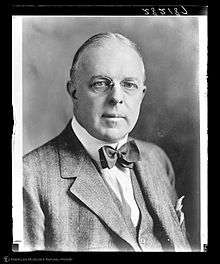Charles Hayden (banker)
Charles Hayden (July 8, 1870 – January 8, 1937) was an American banker, businessman, financier and philanthropist. He was the senior partner of Hayden, Stone & Co. and his influence was such that James W. Gerard listed him among those "who are too busy to hold political office, but determine who shall."[1] Noted contributions bearing his name include the Hayden Planetarium[2] in New York, the Charles Hayden Planetarium at Boston's Museum of Science,[3] and the Charles Hayden Foundation. Instrumental in the financing of Arizona copper mines and smelters, the smelting community of Hayden, Arizona was named for him.
Charles Hayden | |
|---|---|
 Photo showing Charles Hayden in 1934, from the American Museum of Natural History Digital Special Collections | |
| Born | July 8, 1870 Boston, Massachusetts, United States |
| Died | January 8, 1937 (aged 66) New York, New York, United States |
| Education | Massachusetts Institute of Technology |
| Known for | Copper mining investment and brokerage |
| Parent(s) | Josiah Willard Hayden, Emma A. (Tirrill) Hayden |
Background
Hayden was born in Boston, Massachusetts to Josiah Willard Hayden and Emma A. (Tirrill) Hayden. His father was a shoe and leather merchant and he was educated in the public schools before enrolling at the Massachusetts Institute of Technology. Hayden studied mining investment and graduated in 1890. Following graduation, he traveled for a year before taking a position as clerk with the Boston bank of Clark, Ward, & Co.[1]
Hayden was a bachelor his entire life and lived at the Savoy-Plaza Hotel in Manhattan.[4] His hobbies included steeplechase and bridge.[1]
Career
In 1892, Hayden joined with fellow Clark, Ward, & Co. clerk Galen L. Stone to open Hayden, Stone & Co.[1] Hayden gained a reputation for quick decisions and mastery of the brokerage business.[4] Foreseeing the needs of electrification, Hayden made his fortune by investing in copper mining. The new investment firm prospered, expanding from its Boston base to open a New York City branch in 1906.[1]
In addition to his brokerage firm, Hayden was involved in other business operations. During his lifetime he was appointed director to 89 companies, and held 58 directorships at the time of his death.
Philanthropy
Hayden was involved with philanthropy most of his life. During the First World War, he donated US$100,000 per year to the American Red Cross. He later became interested in helping youth and in 1926 was revealed to have anonymously donated US$100,000 to establish an uptown New York City branch of the Boys Club. This was followed in 1933 when, at the request of President Franklin D. Roosevelt, Hayden chaired the Boy Scout Maintenance Fund for the Boy Scouts of America.[1]
In addition to youth, Hayden routinely donated to aid the poor.[1] In 1934, he donated US$150,000 to New York's American Museum of Natural History for creation of a planetarium which was named after him. This was followed the next year when he headed a committee which raised $9,440,000 to save New York's charitable hospitals.[1]
Charles Hayden Foundation
Hayden's largest philanthropic effort came following his death on January 8, 1937 when his will directed roughly US$50,000,000 ($889 million in today's dollars) from his estate be used to create a foundation to advance the education and "moral, mental, and physical well-being" of boys and young men.[5] The Charles Hayden Foundation makes grants of between US$10,000,000 and US$20,000,000 annually to support programs for children in the Boston and New York metropolitan areas.[6]. The Foundation has also funded the construction of the Charles Hayden Library[7] of humanities and science at Hayden's alma mater MIT, and dormitories named Hayden Hall[8][9] at Stevens Institute of Technology in Hoboken, New Jersey and the New York University School of Law in New York City.
References
- "Charles Hayden, Banker, Dies at 66". The New York Times. January 9, 1937. p. 17.
- "Archived copy". Archived from the original on 2006-03-06. Retrieved 2016-01-14.CS1 maint: archived copy as title (link) CS1 maint: BOT: original-url status unknown (link) Accessed 2008-02-19
- History of the Museum of Science Accessed 2008-02-19
- "For Nobler Men". Time. January 25, 1937.
- "Hayden Will Gives $50,000,000 Estate to Educate Youth". The New York Times. January 13, 1937. p. 1.
- Charles Hayden Foundation Grants Accessed 2014-03-15
- "Hayden Library".
- "Campus Information 2015-2016".
- "Hayden Hall".